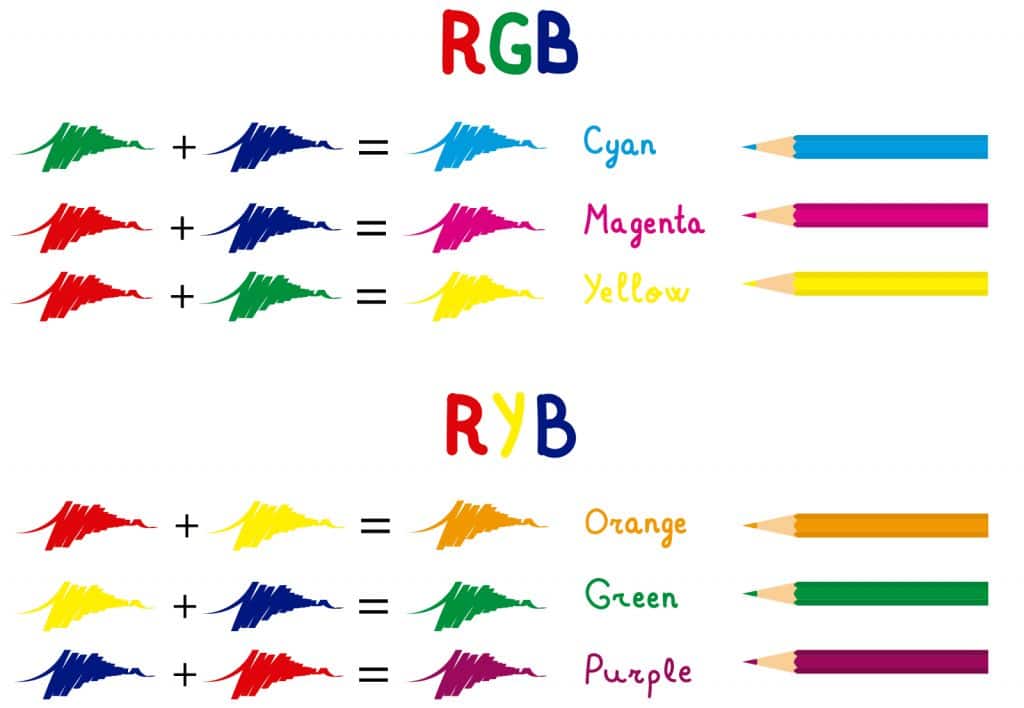Mixing primary colors to create secondary colors is a basic concept in color theory. The primary colors are red, yellow, and blue. When you mix two primary colors together in equal parts, you get a secondary color. The secondary colors are orange, green, and purple. Understanding how to mix the primaries to create secondaries is important for artists, designers, and anyone who wants to experiment with color mixing.
What are the primary colors?
The primary colors are red, yellow, and blue. These are called primaries because they cannot be created by mixing other colors together. Primary colors are the basic building blocks used to create all other colors.
| Red | Yellow | Blue |
In traditional color theory, the primary colors used are red, yellow and blue because they cannot be created by mixing other colors. In modern color theory, the primaries are red, green and blue, which refer to the colors of light. But for mixing pigments like paint, ink or dye, the traditional primaries are used.
What are secondary colors?
Secondary colors are created by mixing two primary colors together. The secondary colors are orange, green, and purple.
| Orange | Green | Purple |
Secondary colors are made up of the primaries on either side of them on the color wheel. For example:
– Orange is made by mixing red and yellow.
– Green is made by mixing yellow and blue.
– Purple is made by mixing blue and red.
The secondary colors are extremely useful for shading and coloring. Once you have the primary colors, you can mix a broad range of hues by blending the primaries and secondaries.
How to mix secondary colors from primaries
Mixing the secondary colors only requires two primary colors but the proportions must be correct to achieve the pure secondary shades.
Mixing Orange
Orange is made by mixing red and yellow. The simplest way is to use equal parts of pure red and pure yellow.
For paint mixing:
– Take some red paint and some yellow paint
– Mix them together in a 1:1 ratio, meaning the same amount of each
– The resulting color will be orange
For light mixing:
– Project a beam of red light and a beam of yellow light onto the same spot
– The overlapping light will appear orange
Mixing Green
Green is made by mixing yellow and blue. As with orange, mixing equal parts yellow and blue will give you the true secondary green.
For paint:
– Take yellow paint and blue paint
– Mix them together using equal amounts of each color
– The mix will produce green
For light:
– Overlap a yellow beam of light and a blue beam of light
– The intersection of the lights will show green
Mixing Purple
Purple requires mixing blue and red. You can achieve a nice purple by mixing equal amounts of vivid blue and vivid red.
For paint:
– Combine blue paint and red paint in a 1:1 ratio
– Stir together to get purple
For light:
– Point a red light beam and a blue light beam at the same spot
– The overlapping light will appear purple
Tips for mixing accurate secondary colors
Here are some tips to get the purest secondary colors when mixing primaries:
– Use pure hues of red, yellow and blue rather than shades like crimson or aqua.
– Make sure to use equal parts and thoroughly mix the primaries. Too much of one color will skew the resulting secondary.
– Start with small amounts of paint until you get the hue you want. You can always add more.
– Mixing light is easier than mixing pigments. Light produces more vivid secondary colors.
– Different paints and inks have different properties so the mixing ratios may vary slightly. Some trial and error is needed.
– Understand color bias. Some reds, blues or yellows naturally skew slightly cool, warm or dull so this affects the mixed secondaries.
– White will desaturate and tint any mixed color. Adding black will darken and mute it.
Using complementary colors
Something important to note is that the secondary colors are complementary to their primary color pairs. This means they sit opposite each other on the color wheel.
For example:
– Orange is complementary to blue
– Purple is complementary to yellow
– Green is complementary to red
Complementary colors create a strong visual contrast when placed side by side. This makes them useful for accenting each other in any design.
| Complementary Color Pairs | Orange and Blue | Purple and Yellow | Green and Red |
The high contrast of complements draws attention and adds vibrance. You can leverage complementary secondaries and primaries to make your artwork or designs really pop.
Importance of secondary colors
Secondary colors have an important role in art and design. Here are some key benefits:
– Allow shading and tinting primary colors to create a wider palette.
– Add visual interest with their complements.
– Help convey warmth or coolness. Orange feels warm, purple cool.
– Useful for color schemes based on triads or tetrads.
– Allow subtle transitions between primaries on the color wheel.
Overall, secondary colors expand the range of hues available from just the primaries. Understanding how to mix secondaries gives control over color and unlocks new possibilities.
Conclusion
Mixing primary colors to create the secondary colors is basic color theory that every artist should know. By combining red, yellow and blue in different pairs, you can create the vivid secondary hues of orange, green and purple. Mix the primaries in equal ratios for clean secondaries. Also pay attention to complementary pairs which offer bold contrast. Mastering color mixing unlocks new depth and dimension for any creative endeavor.


